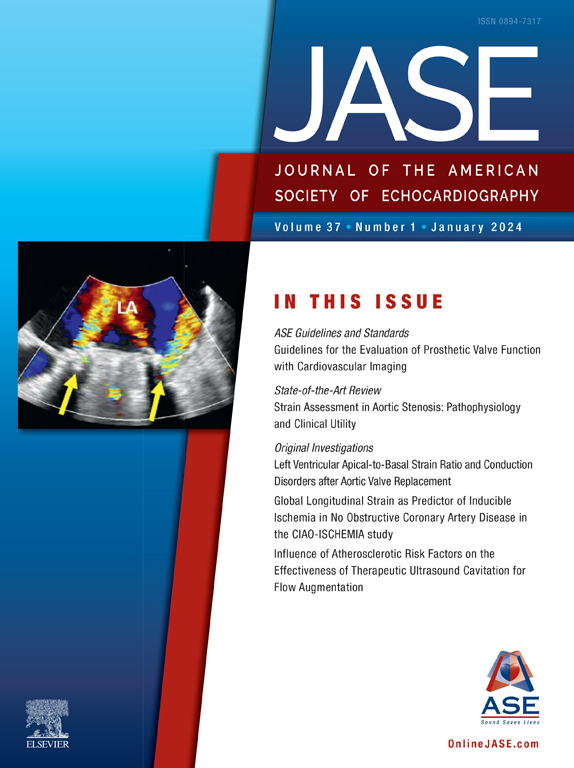Echocardiographic Estimate of Pulmonary Capillary Wedge Pressure Improves Outcome Prediction in Heart Failure Patients With Reduced and Mildly Reduced Ejection Fraction
IF 5.4
2区 医学
Q1 CARDIAC & CARDIOVASCULAR SYSTEMS
Journal of the American Society of Echocardiography
Pub Date : 2025-07-01
DOI:10.1016/j.echo.2025.04.005
引用次数: 0
Abstract
Background
An echocardiographic algorithm to estimate pulmonary capillary wedge pressure (ePCWP) and pulmonary vascular resistance (ePVR) has been recently validated versus right heart catheterization.
Objective
To assess the prognostic significance of these measures in heart failure (HF) patients with reduced and mildly reduced ejection fraction.
Methods
Consecutive outpatients with HF and left ventricular ejection fraction (LVEF) <50% undergoing echocardiography were selected and followed up for the composite end point of all-cause death or HF hospitalization.
Results
Out of 2,214 patients (71 ± 12 years, 76% males, LVEF 35% ± 9%), ePCWP (16 ± 6 mm Hg) was elevated (>15 mm Hg) in 52% of cases and ePVR (1.7 ± 0.7 Wood units) was elevated (>2 Wood units) in 25% of cases. Patients with increased ePCWP were older and had a higher New York Heart Association class, more pronounced cardiac remodeling, systolic/diastolic dysfunction, and neurohormonal activation, particularly when ePVR was also elevated (P < .001). Over a median follow-up of 33 (17-48) months, both measures stratified patients for the risk of the primary end point (log-rank 151 for ePCWP and 60 for ePVR; P < .001). At adjusted regression analysis, ePCWP (hazard ratio for 1 mm Hg increase 1.03 [95% CI, 1.01-1.04]; P < .001) but not ePVR (P = .07) predicted the primary end point, even in patients with atrial fibrillation (P = .019), outperforming current diastolic dysfunction grading (P < .001) and both E/e’ and left atrial volume index (P < .001). The addition of ePCWP to a multivariable prognostic model improved the accuracy of risk prediction (P < .001).
Conclusion
The echocardiographic estimates of PCWP retained clinical and prognostic significance in a large contemporary cohort of patients with chronic HF and LVEF <50%.
超声心动图估计肺动脉毛细血管楔压可改善射血分数降低和轻度降低心衰患者的预后预测。
背景:超声心动图算法估计肺毛细血管楔压(ePCWP)和肺血管阻力(ePVR)最近被证实与右心导管。目的:评价这些指标对心力衰竭(HF)患者射血分数降低和轻度降低的预后意义。方法:连续门诊HF和左室射血分数(LVEF)患者2214例(71±12岁,76%男性,LVEF 35±9%),ePCWP(16±6 mmHg)升高(>15 mmHg)的52%,ePVR(1.7±0.7 Wood Units [WU])升高(>2 WU)的25%。ePCWP升高的患者年龄较大,NYHA等级较高,心脏重构、收缩/舒张功能障碍和神经激素激活更明显,特别是当ePVR也升高时(结论:超声心动图估计PCWP在当代慢性HF和LVEF患者中具有临床和预后意义
本文章由计算机程序翻译,如有差异,请以英文原文为准。
求助全文
约1分钟内获得全文
求助全文
来源期刊
CiteScore
9.50
自引率
12.30%
发文量
257
审稿时长
66 days
期刊介绍:
The Journal of the American Society of Echocardiography(JASE) brings physicians and sonographers peer-reviewed original investigations and state-of-the-art review articles that cover conventional clinical applications of cardiovascular ultrasound, as well as newer techniques with emerging clinical applications. These include three-dimensional echocardiography, strain and strain rate methods for evaluating cardiac mechanics and interventional applications.

 求助内容:
求助内容: 应助结果提醒方式:
应助结果提醒方式:


